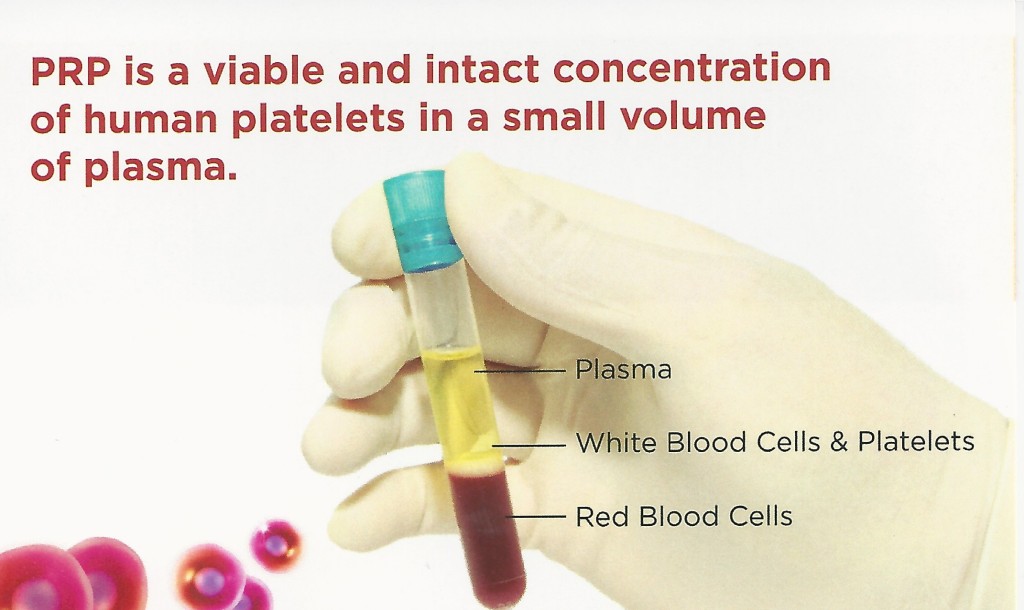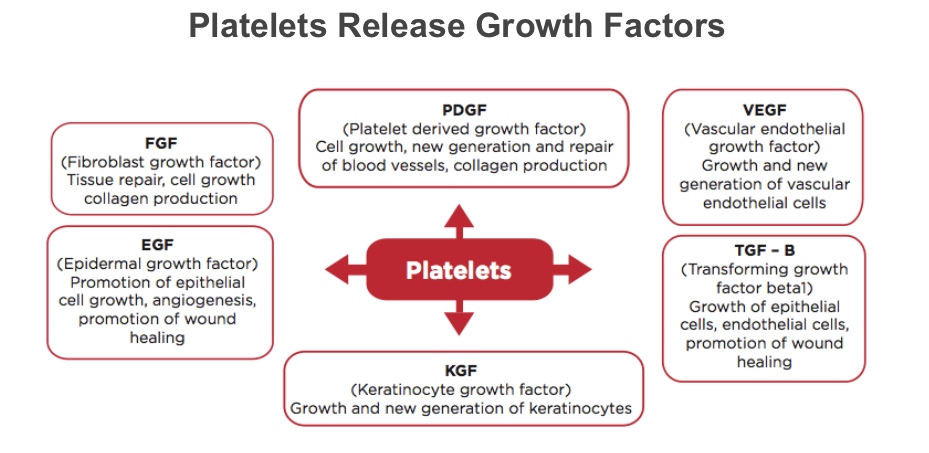Using proprietary new technology, you can now receive Platelet Rich Plasma (PRP) Therapy to stimulate healing and repair damaged or aging joints, skin and other connective tissue. PRP safely stimulates the production and regeneration of healthy new collagen and other cells needed to build cartilage, repair damaged ligaments and tendons and erase wrinkles. This is no longer considered experimental and does not use embryonic stem cells or anything other than a patient’s own Platelet Rich Plasma to restore the youthful volume, strength and integrity to your own joint cartilage, ligaments, tendons and skin.
If you have been told you need a $50,000 knee or hip replacement surgery, you should consider PRP first.
PRP treats:
- Osteoarthritis of the Knee, Shoulder, Hip and Spine
- Rotator Cuff Tears
- Chronic Plantar Fasciitis
- ACL Injuries
- Pelvic Pain and Instability
- Back and Neck Injuries
- Tennis Elbow
- Ankle Sprains
- Tendinitis
- Ligament Sprains
- Wrinkling of the Skin

When our bodies are injured, we undergo several natural stages of healing. The initial stage is the inflammatory stage, and platelets play an important role in this first phase of healing. Platelets are naturally-occurring substances in blood, and comprise approximately 10% of the blood’s cellular components along with white blood cells (WBC), red blood cells (RBC) and plasma. Platelets contain growth factors and many bioactive ingredients that are crucial to the body’s natural healing process. Platelets stimulate the migration of your own stem cells into the area to help repair tissue and cellular damage. The PRP is activated to release at least eight essential growth factors and signaling proteins that augment and enhance the natural restorative healing process. Because all constituents retrieved in PRP are exclusively from the patient, there is virtually no risk of intolerance.
What is PRP?
Platelet Rich Plasma (PRP) is the portion of the yellowish-clear portion of the blood that is concentrated with platelets and growth factors that initiate and accelerate tissue repair and regeneration. It is obtained by drawing blood into a proprietary blood collection tube and then using a centrifuge to separate the red and white blood cells to isolate a concentrated amount of platelets. All PRP is not the same, and there are varying concentrations of platelets, WBCs and RBCs depending on the technique and the manufacturer of the harvesting equipment. Recent studies have shown that the optimal platelet concentration appears to be a 3-6 fold concentration. More is not always better. The use of highly concentrated platelet preparations appear to have unwanted or inhibitory influences on certain growth factors. ![]()

How Does PRP Help Heal The Body?
The body’s first response to soft tissue injury is to deliver platelet cells to the area. Packed with growth and healing factors, platelets initiate repair and attract the critical assistance of stem cells. PRP’s concentrated healing growth factors intensify the body’s natural healing efforts by delivering a higher concentration of platelet derived growth factors directly into the area in need of repair. To create PRP, a small sample of your blood is drawn (similar to a lab test sample) and placed in a centrifuge that spins the blood at high speeds, separating the platelets from the other components. The process removes the unwanted blood components and produces a 3-6 times higher concentration of platelets. The PRP is then injected into and around the point of injury, jump-starting and significantly strengthening the healing process. Because your own blood is used, there is no risk of a transmissible infection and a low risk of allergic reaction.
Studies Confirm Effectiveness of PRP
A recent study conducted by researchers from Hospital for Special Surgery found that Platelet-Rich Plasma (PRP) treatment improved pain and function for patients with knee osteoarthritis, with 73% of patients seeing delays in the progression of the disease. While previous studies have found that patients with osteoarthritis can lose nearly five percent of cartilage per year, this study discovered that a majority of patients had no further cartilage loss following the treatment.
PRP is a new treatment option intended to relieve knee pain, rebuild collagen (the major building block of cartilage, tendons and ligaments) and restore function without the risk of surgery. When the soft tissue of the knee is injured, the body reacts by delivering platelets back to the injured site to attract stem cells and begin the natural healing process. With PRP, this process is intensified as a high concentration of platelets is delivered to speed up healing.
How Long Does the Procedure Take?
The procedure typically takes about one hour, including the blood draw, PRP preparation and injection. Performed safely in a medical office, PRP therapy relieves pain and restores strength, stability and range of motion without the risks of surgery, general anesthesia, or hospital stays and without a prolonged recovery. In fact, most people return to their jobs or usual activities right after the procedure.
How Often Should the Procedure be Done?
Although each case is considered individually, Dr. Hansen has found that the best results are obtained by giving a series of 10 PRP injection over a per week for 14 weeks: 1 PRP injection per week for 6 weeks, followed by 1 injection every other week for the last 8 weeks. This procedure has a cumulative effect that stimulates tissue repair and enhanced production of new collagen and other organized connective tissue, including ligaments, tendons, and cartilage, to regenerate healthy, stronger and more flexible joints. In addition to PRP, specialized physical therapy using ARP Wave electro-stimulation is recommended after the series of PRP injections to strengthen the associated muscles.
What are the Expected Results?
Initial improvement is typically seen within a few weeks, which gradually increases as the healing progresses. The PRP provides almost immediate benefits of cushioning and relief to painful joints. Each PRP session builds on the previous injection providing cumulative benefits that continue to reduce more pain each week while it also increases flexibility. Research studies and clinical practice have shown PRP therapy to be extremely effective at relieving pain and restoring function. Both ultrasound and MRI images have shown definitive tissue repair with PRP therapy, confirming the healing process. The need for surgery can be greatly reduced or eliminated by restoring healthy cartilage, ligaments and tendons before the damage becomes irreversible.
What are the Costs?
PRP injections cost approximate $550 per injection, or $5500 total for all 10 injections of the treatment series. Currently Dr. Hansen is offering the entire series of 10 Treatments for the introductory price of $3500 when paid by cash in advance. He believes that this amazing new therapy is so effective that anyone considering joint replacement surgery needs to seriously consider PRP therapy first. Please tell your friends and family that there is a safe and effective natural alternative to joint replacement surgery. For more information or to schedule a FREE consultation with Dr. Hansen to see if PRP Therapy is right for you, make an appointment or call today 480-991-5092!
PRP Rejuvenates the Skin too!
 Micro-needling uses a sterile needle-tip containing 12-13 tiny micro-needles to create controlled micro-injuries to the skin. This initiates the skin’s repair process to naturally produce collagen and elastin, ideal for smoothing fine lines, wrinkles, acne scars, traumatic scars, and stretch marks. Micro-channels created by the treatment allow for optimal absorption of topical products and Platelet Rich Plasma (PRP), enhancing their effects in the deeper layers of skin.
Micro-needling uses a sterile needle-tip containing 12-13 tiny micro-needles to create controlled micro-injuries to the skin. This initiates the skin’s repair process to naturally produce collagen and elastin, ideal for smoothing fine lines, wrinkles, acne scars, traumatic scars, and stretch marks. Micro-channels created by the treatment allow for optimal absorption of topical products and Platelet Rich Plasma (PRP), enhancing their effects in the deeper layers of skin.
What can I expect after a Micro-Needling procedure?
The skin will be red and flushed, similar to a mild to moderate sunburn, for 12 hours to 3 days. You may also experience mild swelling, tightness, and/or mild peeling. Side effects are temporary and typically resolve within 3 days. Total healing time depends on the depth of the treatment, skin type, and skin condition, and some patients may heal completely in 24 hours. Patients typically notice an immediate glow, but visible improvement will take about 2-4 weeks and can continue for up to 6 months.
How many Micro-Needling treatments will I need?
A series of 3-6 treatments spaced 4-6 weeks apart is ideal for optimal results. Some conditions like deep wrinkles, advanced photo-aging, stretch marks, and acne scars may need 6-8 treatments.
Micro-Needling and (PRP) Therapy
When used for skin rejuvenation, PRP releases growth factors into the skin to expedite the body’s own repair process and stimulate new collagen and elastin. The PRP is applied topically to the skin during a micro-needling procedure. The micro-channels created by micro-needling provide direct pathways to the deeper layers of skin to stimulate connective tissue regeneration and younger looking, healthier skin. Micro-needling with PRP application is an ideal treatment for smoothing fine lines, wrinkles, and scars or even increasing volume and restoring the youthful appearance of your skin.
For more information or to schedule a FREE consultation with Dr. Hansen to see if PRP Therapy is right for you, make an appointment or call today 480-991-5092!


